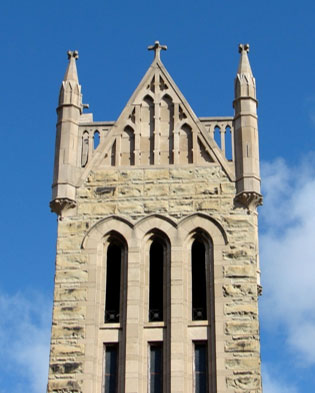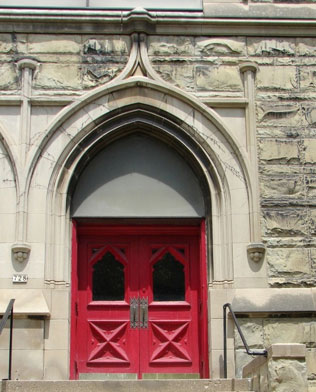41. Summerfield Methodist Episcopal, 1904
Now Summerfield United Methodist
728 East Juneau Avenue (at Cass Street)
Architects: Turnbull and Jones (Elgin, Illinois)

Summerfield Methodist began as the Jackson Street Methodist Episcopal Church, the first church of this denomination on the East Side. Organized in 1852 as a mission of the Spring Street Methodist Episcopal Church, the Jackson Street church became independent the following year. The congregation built a new church at Biddle Street (now Kilbourn Avenue) and Van Buren Street in 1857. A large church building for its time in Milwaukee, the Biddle Street church served the congregation for almost half a century, until completion and dedication of the present church in 1905. The Biddle Street church was converted to commercial uses after 1905 and demolished in 1940 in conjunction with the widening of Kilbourn Avenue.
The congregation changed the name of its church to Summerfield Methodist Episcopal in 1857, in honor of the Irish-born Methodist minister John Summerfield. Arriving in the United States in 1821, Summerfield was an important figure in the Second Great Awakening, an American religious revival spanning from the 1790s to the 1840s. The popularity of Summerfield’s preaching contributed to the rapid growth of the Methodist denomination during this period.
The present church on Juneau Avenue at Cass Street is clad in sandstone quarried in southern Ohio. The masonry is laid in alternating courses of larger and narrower stones, with the outer faces having a rough, quarry-faced surface. In contrast, the limestone used for door and window surrounds and ornamental details is cut to a smooth finish. Prior to the construction of Summerfield Methodist, nearly all of the Gothic Revival churches in Milwaukee had steeples. The bell tower of this church never had a steeple, and from this time on, bell towers without steeples are much more common than those with steeples.
Summerfield Methodist was built as an Akron Plan church, with a two-story polygonal wing to the west of the worship space that housed Sunday school facilities. The Akron Plan is named for the First Methodist Episcopal Church in Akron, Ohio, where the design was first used just after the Civil War. Popular for many years with the Methodists and some other Protestant denominations, Akron Plan churches have a Sunday school wing adjacent to the worship space, with sliding doors or panels that can be opened on those occasions when a larger capacity is needed for services. The Sunday school wing includes a large central room for group activities, which becomes part of the worship space when the sliding panels are opened. At Summerfield Methodist, the central room of the Sunday School wing was labeled a “lecture room” on the original plans by architects Turnbull & Jones. This lecture room was two stories high, ringed by smaller classroom spaces on the main floor and a semi-circular balcony above the classroom spaces. Glass panels would slide upward to open the lecture room to the main worship space.
A remodeling of the church in the early 1960s replaced the moveable panels with the present fixed panels of stained glass, so that the lecture room can no longer be opened to the auditorium. Although it no longer functions as an Akron Plan church, the worship space retains much of its original detailing and character. However, like most churches of this period and earlier, it undoubtedly had a more complex and generally darker painting scheme originally, rather than the present off-white walls and ceiling.
Sources:
A Century of Service: Summerfield Methodist Church Centennial Observance, May 18-25, 1952. Summerfield Methodist Church, 1952.
Colver, Newton, et al., eds. One Hundred Years of Methodism in Greater Milwaukee. General Committee of Milwaukee’s 1935 Methodist Centennial, 1935.
The History and Handbook of Summerfield Methodist Episcopal Church, Milwaukee, Wisconsin. Summerfield Methodist Episcopal Church, 1906.
Leenhouts, Willis and Lillian, architects. Drawings for remodeling of Summerfield Methodist Episcopal Church, dated March 15, 1961. Wisconsin Architectural Archive, Milwaukee Central Library, drawing set 242-10.
Summerfield United Methodist Church. Website at www.summerfieldchurch.org.
“Widen Street; Church to Fall,” Milwaukee Journal, March 31, 1940, page 11, column 1.

